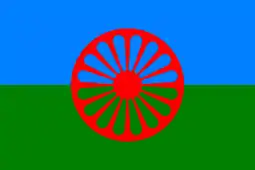Romani people in Syria
The Domari-speaking (or rather, historically speaking) community in Syria, commonly identified as Dom and Nawar (and simply "gypsies" in English), is estimated to number 100–250,000[1] or 250–300,000 people.[2] The vast majority is sedentary.[1] There are semi-nomadic groups, some moving outside the country.[2] In Aleppo, the Dom community is probably the largest, while they are reported to live in Damascus, Homs and Latakia as well.[3] The community is highly marginalised in society, and they are referred to as Qurbāṭ (ʾərbāṭ in Aleppo) and Qarač in the northern part, and Nawar (widely used in the Levant) elsewhere.[3] These terms are used for various groups that mainly share socio-economic profile.[3] The community is divided into clans.[3]
 Domari / Romani flag | |
| Total population | |
|---|---|
| 250–300,000 (est.) | |
| Languages | |
| Domari and Arabic | |
| Religion | |
| Islam | |
| Related ethnic groups | |
| Kawliya |
The Domari are believed to have migrated from India via Persia. They seem to have been an Indian nomadic caste specializing in metalwork and entertainment.[4] The language is Indo-Aryan, closely related to Central Indian and Northwest Indian.[4] The Dom language (Domari) in the Middle East is known as Nawari.[5] Domari shows Turkic, Kurdish and Arabic influence.[5] There has been a language shift into Arabic.
The exonym "Nawar" could be used sometimes offensively, denoting a contemptible and immoral lifestyle associating them with beggars, itinerants, and thieves.[6]
During the Syrian civil war, there were several reports regarding Syrian Dom immigrants in Turkey, Lebanon and Jordan.[7][8][9][10][11]
See also
References
- Berland & Rao 2004, p. 73.
- Williams 2001.
- Herin 2012.
- Matras 2012, p. 1.
- Law 2014, pp. 138–139.
- Berland, Joseph C. (2004). Customary Strangers: New Perspectives on Peripatetic Peoples in the Middle East, Africa, and Asia. Westport, Connecticut: Praeger Publishers. p. 71. ISBN 0-89789-771-4. Retrieved 2013-10-28.
- Proposal for a Regional Social Inclusion Strategy Turkey, Lebanon and Jordan
- The Dom: The Other Asylum Seekers from Syria Report
- Inventory study on adaptation of Syrian refugees to civil life in Turkey
- Suriyeli Dom Göçmenler: En Alttakiler
- Dom Research Center
Sources
- Yaron Matras (1 October 2012). A Grammar of Domari. Walter de Gruyter. pp. 1–. ISBN 978-3-11-029142-1.
- Williams (2001), The Gypsies of Syria, Dom Research Center
- Herin, B. (2012). "The Domari language of Aleppo (Syria)" Linguistic Discovery 10 (2), 1-52.
- Joseph C. Berland; Aparna Rao (2004). Customary Strangers: New Perspectives on Peripatetic Peoples in the Middle East, Africa, and Asia. Greenwood Publishing Group. pp. 71–74. ISBN 978-0-89789-771-6.
- Ian Law (17 October 2014). Mediterranean Racisms: Connections and Complexities in the Racialization of the Mediterranean Region. Palgrave Macmillan. pp. 139–. ISBN 978-1-137-26348-3.
- Tarlan, K.V. (2015). From The Occupation of Iraq to ” The Arab Spring ”: Gypsies in the Middle East
http://www.domresearchcenter.com/journal/current.html
- Tarlan, K.V. (2016). The Dom Gypsies: “Other” Refugees of Syria https://tr.boell.org/sites/default/files/alternatif_02_eng.pdf
- Tarlan, K.V. (2015).Irak'ın işgalinden "Arap Baharı"na Ortadoğu'da Çingeneler: Öteki sığınmacılar. Birikim Dergisi, https://www.birikimdergisi.com/kisi/6595/kemal-vural-tarlan#.Xgn5ES3BLGJ
- Tarlan, K.V., Foggo, H., (2016). Dom Migrants from Syria: Living at the Bottom on the Road amid Poverty and Discrimination. Ankara: Development Workshop, http://www.ka.org.tr/dosyalar/file/Yayinlar/Raporlar/TURKCE/04/DOM%20RAPOR%20TR.pdf
- Tarlan, K.V. (2018). Encouraging Integration and Social Cohesion of Syrian Dom Immigrants Proposal for a Regional Social Inclusion Strategy Turkey, Lebanon, and Jordan. Gaziantep: Kırkayak Kültür http://www.middleeastgypsies.com/wp-content/uploads/2017/06/DOM-RAPOR-EN.pdf